The National Commission for Scheduled Tribes (NCST) has now raised concerns over suspected irregularities in the forest clearance granted for the 72,000-crore Great Nicobar Island (GNI) Project.

What is GNI Project?
- The GNI Project is an abbreviation for the “Holistic Development of Great Nicobar Island,” which is a proposed megaproject being piloted by NITI Aayog.
- The project’s goal is to develop the southern end of the Andaman and Nicobar Islands in the Bay of Bengal by building –
- Transshipment port
- Dual-use military-civil international airport
- Power plant and
- A township over a span of 30 years on more than 160 sq. km of land, of which 130 sq. km is primary forest
Features of the East Project
- Transshipment Hub: By becoming a key player in cargo transshipment, the projected port will enable Great Nicobar to participate in the regional and global maritime economies.
- The port would be administered by the Indian Navy, while the airport will provide dual military-civilian functions as well as tourism.
- Roads, public transit, water supply, and waste management facilities, as well as multiple hotels, have been planned to cater to tourists.
Significance of the project
(1) Economic significance
- Making India a transshipment giant: Because it is located equidistant between Colombo, Port Klang (Malaysia), and Singapore, the proposed port will allow GNI to become a big participant in freight transshipment.
- It is located close to the East-West international shipping corridor, which sees a large portion of the world’s shipping commerce.
- Huge source of revenue: The projected ICTT might serve as a hub for cargo ships passing along this route.
(2) Strategic significance
- Securing the Indian Ocean Region: The proposal to develop GNI has been on the table since the 1970s, and it has been frequently emphasised as a critical component for national security and the consolidation of the Indian Ocean Region.
- Great Nicobar is equidistant from Colombo to the southwest and Port Klang and Singapore to the southeast, an area through which a significant portion of the world’s shipping commerce passes.
- The ANI serves as an oceanic outpost for mainland India.
- Combating Chinese presence: The rising Chinese presence in the Indian Ocean has increased the importance of this need.
Project Problems Threat to Biodiversity
- The construction of the port, airport, and city, as well as the planned inflow of people, are likely to result in habitat damage, fragmentation, and degradation, endangering the survival of various species.
- Displacement of Indigenous Tribes: The Shompen and Nicobaris are two isolated and indigenous tribes who have lived on the island for thousands of years. The initiative has the potential to uproot these tribes and destroy their way of life and culture.
- Deforestation: The project is likely to result in the removal of an estimated 8.5 lakh trees from the island’s prehistoric rainforests, potentially affecting the island’s ecology and wildlife.
- Inadequate Environmental and Social effect evaluations: The project has gotten many quick clearances, raising concerns about the quality of environmental and social effect evaluations.
- Experts have voiced many worries about the islands’ tectonic volatility and disaster vulnerability, which have seen approximately 444 earthquakes in the last ten years. The indigenous groups who were displaced by the 2004 Tsunami are still rehabilitating.
Concerns highlighted by the NCST
(1) Discrepancies with FRA Compliance
- The island administration did not identify or award title of any forest area to local tribespeople as required by the Forest Conservation Rules, 2017, prior to granting Stage-I clearance.
- This is despite the fact that Rule 6(3)(e) of the Forest Conservation Rules-2017 (FCR) requires the District Collector to first identify and vest rights in communities under the FRA.
- The legislation grants forest communities the power to regulate and manage the usage of forest land over which they have ownership, and diverting it requires their agreement.
(2) Inconsistencies with Stage-I Clearance
- The project gained Stage-I approval in October 2022, two years after the application was submitted.
- According to monthly progress reports, the district administration has not processed any requests for forest land under the FRA in the 26 months since project approval.
- With less than a day’s notice to the villagers, a Gramme Sabha meeting was convened, and a resolution was passed approving to the diversion of forest area for the project.
(3) Withdrawal of Consent
- Weeks after the Stage-I permission was given, the Campbell Bay Tribal Council revoked the Gramme Sabha’s consent.
- The NCST claimed that the meeting minutes were typed after members’ signatures were obtained.
Source: https://www.thehindu.com/news/national/tamil-nadu/ngt-constitutes-high-powered-committee-to-revisit-environmental-nod-granted-to-great-nicobar-island-project/article66709708.ece
